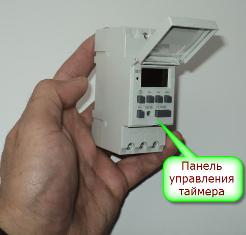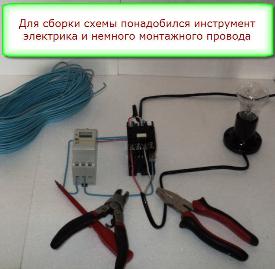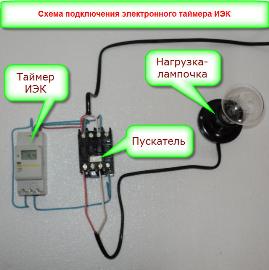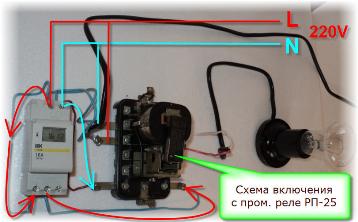Categories: Electrician Secrets, Home automation
Number of views: 48867
Comments on the article: 2
Alarm clock on ... lighting! An example of using an electronic timer
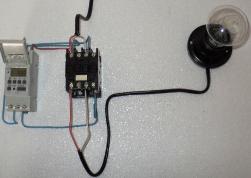 How to make lighting turn on strictly according to schedule? For example, you go to work at 7.40 and return at 17.20 and want the light to be on above the front door at that time.
How to make lighting turn on strictly according to schedule? For example, you go to work at 7.40 and return at 17.20 and want the light to be on above the front door at that time.
Imagine, come to the house, and you are already greeted by a burning lamp and no need to look for a switch in the dark, the light automatically turns on and after a certain time turns off independently, without your participation.
Or another example, you went to rest, but you don’t have an apartment signal, then you can create an “effect of presence”. In your absence, the light in the apartment itself will turn on and off as if no one had gone anywhere.
I know people who turn off water heaters (electric titans) and electric heating boilers during the day, and turn them on only at night - when the night meter tariff starts to count. How to make automatic on / off?
All this can be achieved using a simple electronic timer, which are sold in specialized stores.
I’ll tell you how to use IEK’s timer, which I purchased in the store. The timer is designed to automatically turn on / off electrical equipment after a specified period of time.
In the presented timer, for example, you can enter 11 time cycles. That is, the timer during the day can turn on / off the light 11 times. The minimum time between switching on is 1 minute.
The timer has a built-in sealed battery - an autonomous rechargeable power source that saves parameters if the mains voltage disappears and provides backup power for at least 150 hours.
It is connected very simply. A supply voltage of 220 volts is supplied to the upper terminals, one of the power wires of the lamp or any other electrical device that consumes a current of no more than 16 amperes is connected through the lower terminals.
Why is 16 amperes? It is this maximum current that the internal contacts of the timer can switch.
Simply put, the electronic timer simply closes or opens its contact according to a manually set program. We program it ourselves using the buttons on the front panel. How to program is written in the timer passport, there is nothing complicated. We select the operating mode we need and set the on-off time.
For automatic load control, that is, without our participation, one timer contact is sufficient, the second is not necessary. I clarify this because I was asked a question:
“Why are two wires coming to the bulb, and only one wire goes from the timer to the lamp?”
Who does not know - I answer. The second wire "goes" directly to the lamp. This is the same as the switch for a lamp is connected - the neutral wire is connected directly to the lamp, and a switch is connected to the phase wire break.
It turns out the same thing, only instead of the switch, an electronic timer is installed.
I believe that the electronic timer is very useful for household use and it can find many uses!
The principle of operation and the connection diagram of the electronic timer on video:
See also at bgv.electricianexp.com
:

